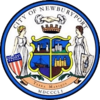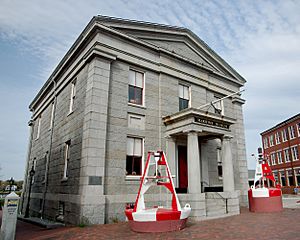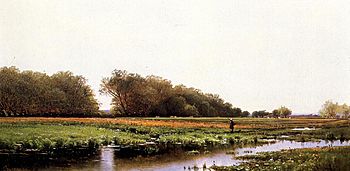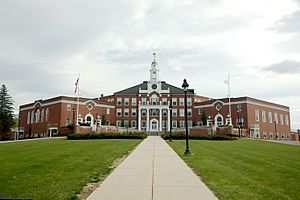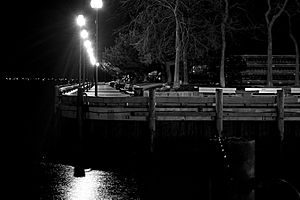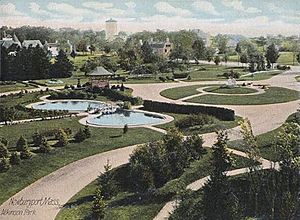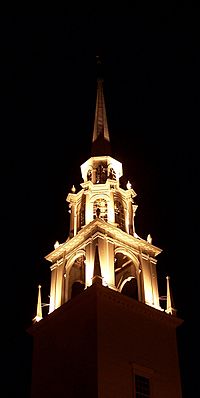Newburyport, Massachusetts facts for kids
Quick facts for kids
Newburyport, Massachusetts
|
||
|---|---|---|
|
City
|
||
|
||
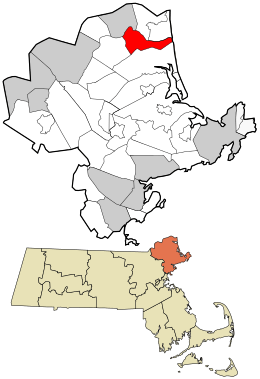
Location in Essex County and the state of Massachusetts
|
||
| Country | United States | |
| State | Massachusetts | |
| County | Essex | |
| Settled | 1635 | |
| Incorporated as a town | 1764 | |
| Incorporated as a city | 1851 | |
| Government | ||
| • Type | Mayor-council city | |
| Area | ||
| • Total | 10.71 sq mi (27.74 km2) | |
| • Land | 8.35 sq mi (21.63 km2) | |
| • Water | 2.36 sq mi (6.11 km2) | |
| Elevation | 37 ft (11 m) | |
| Population
(2020)
|
||
| • Total | 18,289 | |
| • Density | 2,190.30/sq mi (845.66/km2) | |
| Time zone | UTC−5 (Eastern) | |
| • Summer (DST) | UTC−4 (Eastern) | |
| ZIP Code |
01950
|
|
| Area code(s) | 351/978 | |
| FIPS code | 25-45245 | |
| GNIS feature ID | 0614293 | |
Newburyport is a city on the coast in Essex County, Massachusetts. It's about 35 miles (56 km) northeast of Boston. In 2020, about 18,289 people lived there.
Newburyport is a historic seaport, which means it was once a very important port city for ships. Today, it's a lively place for tourists. Part of the city is on Plum Island. Many people in Newburyport enjoy boating, and the city earns a lot of money from storing and fixing boats. The Coast Guard helps keep boating safe, especially near the Merrimack River where the water currents can be strong.
The city is easy to reach by major highways like Interstate 95 and U.S. Route 1. You can also take the MBTA commuter rail from Boston right to Newburyport.
Contents
- Newburyport's Past: A City of Ships
- Saving Newburyport's Historic Downtown
- Newburyport's Location and Landscape
- Who Lives in Newburyport?
- Getting Around Newburyport
- Learning in Newburyport
- Fun Things to Do in Newburyport
- Yearly Events and Festivals
- Places to See in Newburyport
- Famous People From Newburyport
- Sister Cities
- Images for kids
- See also
Newburyport's Past: A City of Ships
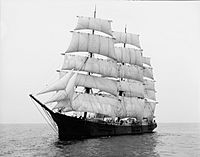
Newburyport became its own town on January 28, 1764. Before that, it was part of Newbury. People living by the water in Newbury were mostly merchants and craftspeople. Those in other parts of Newbury were mainly farmers. This caused some disagreements, so they decided to split into two towns.
The new town of Newburyport was quite small, covering only about 647 acres (2.62 km2). About 2,800 people lived in 357 homes. It had three shipyards, but no bridges. People used ferries to cross the river.
Newburyport grew and became a city in 1851. It was known for fishing, building ships, and shipping goods. It also made silverware. In the past, ships from Newburyport were part of the "triangular trade." This involved importing molasses from the West Indies and exporting rum made from it.
Newburyport and the Fight Against Slavery
Many people in Newburyport were against slavery. Massachusetts ended slavery in 1783. In the early 1800s, about 6,000 runaway slaves found safety in Newburyport. After 1850, a law called the fugitive slave act meant that runaway slaves had to be returned. Because of this, many had to leave the country to stay free. Some white residents of Newburyport helped them escape through the Underground Railroad. For example, Captain Alexander Graves secretly helped slaves travel from the South to Canada.
Newburyport's Maritime History
Newburyport once had a large fishing fleet. It was also a center for privateering during the Revolutionary War and the War of 1812. Privateers were armed ships owned by private citizens, allowed by the government to attack enemy ships. Later, the city became famous for building fast clipper ships. Today, you won't see many signs of its old shipping days. The busy docks and shipyards are mostly gone, replaced by parking lots.
Important Historical Moments
- The first of many clipper ships were built here.
- Newburyport had one of the first "Tea Party" protests against the British Tea Tax.
- It had the first state mint and treasury building.
- The Newburyport Superior Courthouse is the oldest courthouse in Massachusetts that is still in use.
The Newburyport Five Cents Savings Bank on State Street opened in 1854. It's one of the oldest banks in the United States that is still open today.
Historic Places to Visit
- Cushing House Museum & Garden (built around 1808)
- Newburyport Custom House Museum (built 1835), designed by famous architect Robert Mills
Newburyport in Books
- The city was mentioned in the H. P. Lovecraft story, "The Shadow Over Innsmouth." Lovecraft used Newburyport as inspiration for his fictional town of Innsmouth.
Key Dates in Newburyport's History
- 1635: Newbury was founded.
- 1764: Newburyport became its own town.
- 1773: The Essex Journal newspaper started.
- 1790: The population was 4,837.
- 1851: Newburyport became a city.
- 1854: The Newburyport Public Library was founded.
- 1971: The downtown area was added to the National Register of Historic Places.
- 1970s: The downtown area was renovated and preserved.
Saving Newburyport's Historic Downtown
In the 1950s and 1960s, Newburyport's downtown area started to look run down. This was partly because new shopping centers (called strip malls) opened outside the city. Also, more people used cars to shop in bigger cities nearby. By 1970, there were plans to tear down most of Newburyport's historic downtown. The idea was to rebuild it with new hotels and stores.
But at the last minute, the city decided to save its historic buildings. They got a special grant to help restore the old architecture. Work began in the early 1970s, especially along State Street. They even created a pedestrian mall (a street just for walking) on Inn Street. Newburyport is now a great example of how a city can keep its old charm while still being a modern, active place to live.
Newburyport's Location and Landscape
Newburyport is located at 42°48′45″N 70°52′39″W. The city covers about 10.6 square miles (27.5 km2). Most of this is land, but about 2.2 square miles (5.7 km2) is water.
The city is part of Massachusetts' North Shore. It sits on the raised south bank of the Merrimack River, next to the Newbury marshes. The old shipyards, which are now boatyards, are along the river's edge. Many old colonial homes are on the bank, leading up to High Street. The homes of wealthy ship owners are on High Street. Many of these houses have "widow's walks" on their roofs. These were places where people could watch for ships returning home.
The land slopes down from the ridge to the marsh on the other side. A third street, Low Street, runs along this edge. The Plum Island Turnpike crosses the marsh on a raised road to Plum Island. A drawbridge connects the mainland to the island. On the Newburyport side, there's a small airport called Plum Island Airport near the marsh.
Newburyport has many parks and beaches, including Plum Island Point Beach and Waterfront Park. Maudslay State Park is also in the city, along the Merrimack River.
Newburyport is about 37 miles (60 km) north of Boston. It's also close to the New Hampshire border. The city is surrounded by the Gulf of Maine (Atlantic Ocean) to the east, and towns like Newbury, West Newbury, Amesbury, and Salisbury.
Newburyport's Neighborhoods
- Joppa: This neighborhood is near Newbury and the Plum Island Airport.
- South End: Located south of downtown, next to Newbury and Joppa.
- Plum Island: The northern part of Plum Island is part of Newburyport. It has Plum Island Point, which is great for fishing, and the Plum Island Lighthouse.
Newburyport's Weather
Newburyport has a typical New England climate.
| Climate data for Newburyport, Massachusetts (2000–2016 normals, rainfall/snowfall 1991–2020; extremes 1911–2016) | |||||||||||||
|---|---|---|---|---|---|---|---|---|---|---|---|---|---|
| Month | Jan | Feb | Mar | Apr | May | Jun | Jul | Aug | Sep | Oct | Nov | Dec | Year |
| Record high °F (°C) | 71 (22) |
67 (19) |
85 (29) |
94 (34) |
100 (38) |
97 (36) |
100 (38) |
98 (37) |
96 (36) |
86 (30) |
75 (24) |
70 (21) |
100 (38) |
| Mean maximum °F (°C) | 55 (13) |
54 (12) |
65 (18) |
83 (28) |
88 (31) |
92 (33) |
94 (34) |
92 (33) |
90 (32) |
79 (26) |
69 (21) |
60 (16) |
96 (36) |
| Mean daily maximum °F (°C) | 33.2 (0.7) |
36.2 (2.3) |
44.5 (6.9) |
56.6 (13.7) |
66.5 (19.2) |
75.0 (23.9) |
82.3 (27.9) |
81.0 (27.2) |
74.1 (23.4) |
61.9 (16.6) |
51.5 (10.8) |
40.2 (4.6) |
58.6 (14.8) |
| Daily mean °F (°C) | 24.2 (−4.3) |
26.5 (−3.1) |
34.9 (1.6) |
45.6 (7.6) |
55.9 (13.3) |
64.9 (18.3) |
71.8 (22.1) |
70.1 (21.2) |
63.1 (17.3) |
51.6 (10.9) |
41.8 (5.4) |
31.6 (−0.2) |
48.5 (9.2) |
| Mean daily minimum °F (°C) | 15.2 (−9.3) |
16.8 (−8.4) |
25.3 (−3.7) |
34.6 (1.4) |
45.3 (7.4) |
54.9 (12.7) |
61.3 (16.3) |
59.2 (15.1) |
52.1 (11.2) |
41.3 (5.2) |
32.2 (0.1) |
23.0 (−5.0) |
38.4 (3.6) |
| Mean minimum °F (°C) | −2 (−19) |
2 (−17) |
8 (−13) |
25 (−4) |
32 (0) |
44 (7) |
53 (12) |
50 (10) |
39 (4) |
29 (−2) |
19 (−7) |
9 (−13) |
−4 (−20) |
| Record low °F (°C) | −12 (−24) |
−12 (−24) |
−2 (−19) |
19 (−7) |
28 (−2) |
39 (4) |
48 (9) |
46 (8) |
32 (0) |
25 (−4) |
12 (−11) |
−2 (−19) |
−12 (−24) |
| Average precipitation inches (mm) | 3.68 (93) |
3.63 (92) |
4.72 (120) |
4.45 (113) |
4.11 (104) |
4.27 (108) |
3.51 (89) |
3.49 (89) |
3.90 (99) |
5.15 (131) |
3.99 (101) |
4.86 (123) |
49.76 (1,262) |
| Average snowfall inches (cm) | 18.0 (46) |
16.1 (41) |
13.4 (34) |
1.8 (4.6) |
0.0 (0.0) |
0.0 (0.0) |
0.0 (0.0) |
0.0 (0.0) |
0.0 (0.0) |
0.1 (0.25) |
1.4 (3.6) |
11.1 (28) |
61.9 (157.45) |
| Average extreme snow depth inches (cm) | 11.0 (28) |
12.0 (30) |
10.0 (25) |
2.0 (5.1) |
0.0 (0.0) |
0.0 (0.0) |
0.0 (0.0) |
0.0 (0.0) |
0.0 (0.0) |
0.0 (0.0) |
1.0 (2.5) |
7.0 (18) |
18.0 (46) |
| Average precipitation days (≥ 0.01 in) | 11.5 | 9.3 | 11.6 | 10.9 | 12.0 | 11.9 | 10.2 | 9.4 | 9.1 | 10.6 | 10.4 | 11.5 | 128.4 |
| Average snowy days (≥ 0.1 in) | 6.9 | 5.3 | 4.6 | 0.8 | 0.0 | 0.0 | 0.0 | 0.0 | 0.0 | 0.1 | 1.0 | 4.5 | 23.2 |
| Source: NOAA | |||||||||||||
Who Lives in Newburyport?
| Historical population | ||
|---|---|---|
| Year | Pop. | ±% |
| 1790 | 4,837 | — |
| 1800 | 5,946 | +22.9% |
| 1810 | 7,634 | +28.4% |
| 1820 | 6,852 | −10.2% |
| 1830 | 6,375 | −7.0% |
| 1840 | 7,161 | +12.3% |
| 1850 | 9,572 | +33.7% |
| 1860 | 13,401 | +40.0% |
| 1870 | 12,595 | −6.0% |
| 1880 | 13,538 | +7.5% |
| 1890 | 13,947 | +3.0% |
| 1900 | 14,478 | +3.8% |
| 1910 | 14,949 | +3.3% |
| 1920 | 15,618 | +4.5% |
| 1930 | 15,084 | −3.4% |
| 1940 | 13,916 | −7.7% |
| 1950 | 14,111 | +1.4% |
| 1960 | 14,004 | −0.8% |
| 1970 | 15,807 | +12.9% |
| 1980 | 15,900 | +0.6% |
| 1990 | 16,317 | +2.6% |
| 2000 | 17,189 | +5.3% |
| 2010 | 17,416 | +1.3% |
| 2020 | 18,289 | +5.0% |
| 2023* | 18,731 | +2.4% |
| * = population estimate. Source: United States Census records and Population Estimates Program data. Source: |
||
In 2010, there were 17,416 people living in Newburyport. Most people (90.2%) were White. The top five ethnic groups were:
- Irish – 25%
- English – 16%
- Italian – 11%
- French – 7%
- German – 6%
The average age in the city was 41 years old. About 20.7% of the population was under 18.
Getting Around Newburyport
Interstate 95 runs through the western part of Newburyport. You can also use U.S. Route 1 and Massachusetts Route 1A. These roads cross the Merrimack River on bridges. The Newburyport Turnpike Bridge is the bridge closest to the ocean.
The Merrimack Valley Regional Transit Authority offers bus service in the city. As of March 2023, the bus is free! Newburyport is also the last stop on the Newburyport/Rockport Line of the MBTA Commuter Rail. This train connects the city to Boston's North Station.
Plum Island Airport is a small, privately owned airport in Newburyport. It's open to the public for small planes. For bigger flights, you can go to Logan International Airport in Boston.
Learning in Newburyport
Newburyport has several public schools and private schools. Newburyport High School is one of the oldest public high schools in the United States.
Here are the public schools in Newburyport:
- Francis T. Bresnahan Lower Elementary School: for pre-kindergarten to grade 3
- Edward G. Molin Upper Elementary School: for grades 4 and 5
- Rupert A. Nock Middle School: for grades 6 to 8
- Newburyport High School: for grades 9 to 12
Other schools include:
- River Valley Charter School: for kindergarten to grade 8
- Immaculate Conception Catholic School: for pre-kindergarten to grade 8
- Newburyport Montessori School: for pre-kindergarten and kindergarten
In 2019, the Newburyport School Committee decided to start school later in the morning. This was to help students get more sleep.
Newburyport also has the Newburyport Public Library, where you can find many books and resources.
Sports at Newburyport High School
Newburyport High School's sports teams are called the Clippers. Their colors are crimson and old gold. They play in the Cape Ann League. Here are some of the sports offered:
| Fall | Winter | Spring |
|---|---|---|
| Field Hockey | Basketball | Baseball |
| Football | Indoor Track | Softball |
| Soccer | Ice Hockey | Lacrosse |
| Golf | Ski Racing (with Georgetown High School) | Spring Track |
| Volleyball | Swim (with Triton Regional High School) | Tennis |
| Cross Country | Wrestling (with Pentucket High School) | |
| Cheerleading | Cheerleading |
Fun Things to Do in Newburyport
Newburyport offers many activities for everyone. There's an ice skating rink that's open all year. The city also has a beautiful waterfront and boardwalk. Many people love boating, fishing, and swimming in the water.
The downtown area is great for shopping at unique stores and eating at local restaurants. During festivals, you can enjoy concerts, food, and entertainment. An old mill building on Liberty Street hosts a farmers' market in both summer and winter.
The city also has youth sports leagues for baseball, football, soccer, and more. The youth services program offers classes in robotics, music, rock climbing, chess, cooking, and many other fun activities.
Yearly Events and Festivals
Yankee Homecoming
Yankee Homecoming is a big annual festival that celebrates people coming back home to Newburyport. It started in 1957 to help the city's economy and make people feel good.
The festival lasts for one week. On the first Sunday, called "Olde Fashioned Sunday," there's an art show and an antique car parade. There are also concerts every night at Market Landing Park. Other popular events include road races and a fireworks show on Saturday night. The festival ends with a big parade.
Newburyport's "Yankee Homecoming" is the second-oldest homecoming festival in the United States. Many charities raise money during this event.
Newburyport Literary Festival
This festival happens during the last weekend of April. It started in 2006 to encourage reading and an interest in books. Local authors come to sign books and talk about their work. Schoolchildren also create projects to show to visiting authors.
Newburyport Chamber Music Festival
This festival takes place in early August. It brings talented international musicians to Newburyport. They perform concerts, hold open rehearsals, and even play music in local homes. They often create new music inspired by the area's history and landscape.
Places to See in Newburyport
Newburyport is a popular place for tourists. The charming downtown area has shops and restaurants for all ages.
High Street is famous for its beautiful old Federal-style houses. It connects Atkinson Common and the Bartlett Mall. The Bartlett Mall has the Charles Bulfinch-designed Essex County Superior Courthouse, built in 1805.
The First Presbyterian Church dates back to 1756. Its clock tower bell was made by Paul Revere. A famous preacher named George Whitefield is buried under the pulpit of the "Old South" church, just as he wished when he died in Newburyport in 1770.
Other interesting places include:
- The historic waterfront
- Atwood Park
- Market Square & Inn Street
- Cashman Park
- Brown Square, which has a statue of "Garrison the Liberator" (a famous abolitionist)
- The recently restored City Hall, which has portraits of people who served their country.
- Chain Bridge
- Cushing House Museum & Garden
- Joppa Flats Education Center and Wildlife Sanctuary
- Maudslay State Park
- Newburyport Brewing Company
- Parker River National Wildlife Refuge
Famous People From Newburyport
Many notable people have lived in or come from Newburyport, including:
- John Quincy Adams (1767–1848), who later became a U.S. president.
- Nikole Beckwith (born 1980), a writer and filmmaker.
- Caleb Cushing (1800–1879), a diplomat and politician.
- Timothy Dexter (1748–1806), a businessman known for being unique.
- Andre Dubus III (born 1959), a novelist.
- William Lloyd Garrison (1805–1879), a famous leader against slavery.
- Joe Keery (born 1992), an actor.
- Rufus King (1755–1827), a diplomat and politician.
- Francis Cabot Lowell (1775–1817), a manufacturer.
- Donald McKay (1810–1880), a famous shipbuilder.
- Robert S. Mulliken (1896–1986), who won the Nobel Prize in Chemistry in 1966.
- Jacob Perkins (1766–1849), an early American inventor.
Sister Cities
Newburyport has one sister city: ![]() Bura, Kenya
Bura, Kenya
Images for kids
See also
 In Spanish: Newburyport para niños
In Spanish: Newburyport para niños


